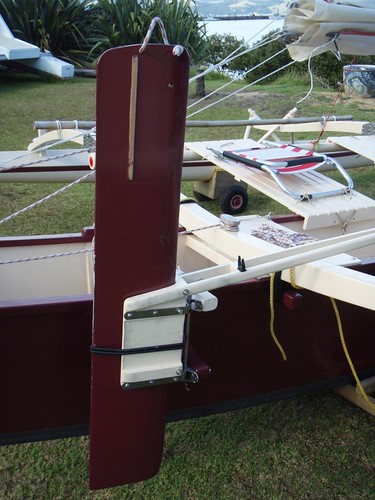Our aim is always to try to use the best technology available for boat plans. However the difference with our plans is that we aim to achieve the highest tech approach using the most common materials. We use the most common type of rudder box used in Australian racing boats over many decades.
It is simple and very robust – providing you don’t leave out the important bolt that holds the tiller to the rudder box at the top.
It completely outperforms swinging rudders in every situation. You can steer in very shallow water, when a swung back blade has no bite but puts a huge load on the tiller. The “kick back” dagger rudder is always light to steer and has excellent bite. You can also sail over an obstacle and the rudder kicks back automatically but then drops back down when you pass over the log or other obstruction.
Gary Dierking of proa fame recently built and tried one of the designs and sounds pretty happy. This is his pic

He wrote
Michael,
I’d just like to thank you for inspiration (and photos) to build one of the “bungy strapped open backed cassette” rudders. I too became frustrated with conventional kickup blades that liked to move just enough at high speed to make steering a pain. I would sometimes use a pin to hold it but of course that can be risky. The bungy design seems to be just the thing and feels very solid too. A slight hum at 5 knots and then it goes away as I speed up.Has there been any problem with the bungy wearing where it rests against the trailing edge? I thought of maybe making a sliding car from polyethylene that the bungy could pass through but it may be unnecessary.
Perhaps a little known advantage of this rudder is the fact that it kicks up in both directions for those times you get washed back onto the beach when trying to launch from a lee shore.
Thanks,
Gary Dierking
I have started to recommend that the bungy (shock cord) is done it two separate and independent loops. That way if one breaks the other will get you home. The trailing edges of my rudder designs are usually about 3 or 4mm (1/8+”) wide and cut square – never rounded. The bungee seems to last a long time. Also a lanyard between the rope handle and the tiller will prevent the loss of the blade.
On the other side … I haven’t seen the bungee break often or ever. But it must happen sometime!!! So a precaution is sensible.
By the way … it is completely appropriate that Gary steals the idea from me. I stole it from one of his compatriots around 1973 when I saw it on a Paper Tiger cat at a regatta. I thought at the time … that is SUPER good idea! That shows the engineering and design instincts of a 13 year old can be quite good! :-)
I spent a couple of seasons breaking these rudders on a series of NS14s until I realised that the bolt through the tiller was essential. If it is there the setup is bulletproof and is much more lightly loaded than any other rudder setup. The tiller takes the direct loads of steering to the rudder blade.
It has been used on all my sailboat designs … except for ones where you can’t get to the back of the boat to raise and lower it. Like my BETH sailing canoe. But it works fine everywhere else!